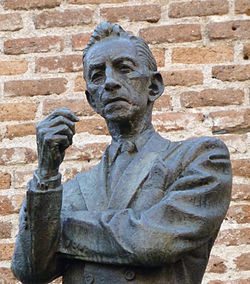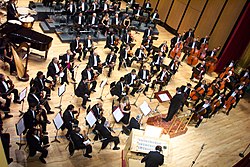Music of Mexico
This article contains too many pictures, charts or diagrams for its overall length. |

| Part of a series on the |
| Culture of Mexico |
|---|
 |
| Society |
|
| Topics |
|
| Symbols |
|
|
The music of Mexico is very diverse and features a wide range of musical genres and performance styles. It has been influenced by a variety of cultures, most notably the culture of the indigenous people of Mexico and Europe. Music was an expression of Mexican nationalism, beginning in the nineteenth century.[1]
History of Mexican music[]
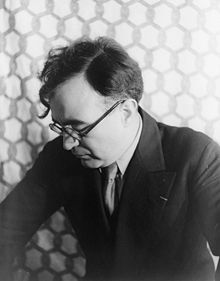
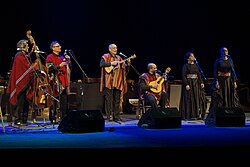
The foundation of Mexican music comes from its indigenous sounds and heritage. The original inhabitants of the land used drums (such as the teponaztli), flutes, rattles, conches as trumpets and their voices to make music and dances. This ancient music is still played in some parts of Mexico. However, much of the traditional contemporary music of Mexico was written during and after the Spanish colonial period, using many old world influenced instruments. Many traditional instruments, such as the Mexican vihuela used in Mariachi music, were adapted from their old world predecessors and are now considered very Mexican.
There existed regional and local musical traditions in the colonial period and earlier, but a national music began to develop in the nineteenth century, often with patriotic themes of national defense and against foreign invaders. Conservative general and president Antonio López de Santa Anna brought a Catalan music master, Jaime Nunó, from nearby Cuba to create a network of military bands on a national scale. He composed the music to the Mexican national anthem. During the French Intervention in Mexico, which placed Maximilian of Habsburg on the throne of the French empire in Mexico, many musicians accompanied his entourage and he established the National Conservatory of Music in 1866.

Liberal President Benito Juárez saw the need to create military bands.[2] Village brass bands proliferated in the late nineteenth century, with concerts in town squares, often on a central kiosk.[3] During the Porfiriato, musical styles expanded, with Mexican national music, cosmopolitan music brought by foreign elites, and European regional music such as polkas, mazurkas, and waltzes, as well as opera overtures. Musicians had access to and used sheet music, indicating musical literacy. In some indigenous regions, new music and bands helped bring a level of unity. In Oaxaca, a waltz, "Dios nunca muere" (God never dies) became the state's anthem, linking regional patriotism with God.[4] A variety of musical styles from elsewhere were incorporated into Mexican popular music in the nineteenth century, including Afro-Caribbean rhythms from Cuba and Haiti. Music, dance, and poetry flourished in the Porfiriato. Mexico's National Conservatory of Music was strongly influenced by Italian masters, who gave way to French influence at the turn of the twentieth century.

Following the Revolution, Venustiano Carranza, leader of the winning Constitutionalist faction of the Revolution, mandated that the National Conservatory "recover the national" in its musical education, abandoning rather than privileging foreign music.Younger Mexican composers emerged, including Carlos Chávez, Silvestre Revueltas, and Luis Sandi, who developed Mexican "art music." Chávez was a prolific composer and one who embraced creating Mexican orchestral music drawing on revolutionary corridos, and composed an Aztec-themed ballet. He became the director of the National Conservatory of Music, which became affiliated with the Ministry of Education (SEP). Revueltas composed music for the new, emerging Mexican cinema, and Sandi created choral works, creating music for civic events, as well as incorporating indigenous music from the Yaqui and Maya regions in his compositions.[5] Chávez is seen as the driving force behind the split between of Mexican art music and traditional styles, privileging art music. However, traditional or folkloric music continues to be popular, and the Ballet Folklórico de México, established in 1952, performs regularly at Bellas Artes.
Traditional folk music[]
Mexican traditional folk music can be classified in two aspects:

- By types of musical forms and styles: corrido, canción Ranchera, Yucatecan trova, Son Huasteco, Yucatecan jarana, Son Jarocho, Mexican Danzón, Mexican Bolero, Son istmeño, Son Jaliscience, Chilena, Son calentano, Son Planeco, and Canto cardenche.
- By types of ensembles: banda, Yucatecan trio, conjunto calentano, conjunto huasteco, conjunto jarocho, conjunto norteño, Yucatecan jarana ensemble, mariachi, and marimba.


Its formal structure is based on the alternation of instrumental sections and the singing of short poetic units called coplas. The mode is usually major, with harmonic vocabulary mostly limited to progressions drawing from I, IV, II7, V and V5. Triple meter (6/8, 3/4, or a combination of both) predominates, with many exceptions in duple meter.[6]
Son is performed most often by giant ensembles in which string instruments predominate, with notable region-specific exceptions like marimba ensembles and wind ensembles.
Mexican Son music developed from the mixing of Spanish music with indigenous music of different regions, hence the music exhibited much variation across the country, in rhythm, melody, and instrumentation.[7] Mariachi can be considered one type of Mexican son. Mexican son also includes various miscellaneous styles. The guitar is universally present in nearly all Mexican son subgenres. Other instruments may include trumpets, violins, and accordions.
- Abajeño music from Jalisco, Colima, and Michoacán. Indigenous communities have produced their own versions of Mexican son, which is otherwise a primarily mestizo genre. The Purépecha (from Michoacán) are known for the sones abajeños, which are often played alongside pirekuas, a form of native love song. Well-known bands include Atardecer and Erandi.
- Chilena from the Costa Chica regions in Guerrero and Oaxaca.
- Istmeños originates from the Zapotecs of Oaxaca and is known for love songs, and the people's sones istmeños, which are sung in both Zapotec and Spanish. The music has been popularized, primarily by pop stars from outside the area, including Lila Downs.
- Son calentano is a melodically complex violin music from the Balsas River Basin of southern Mexico. Juan Reynoso is especially popular, and has won the National Prize for Arts and Sciences.
- Sones de arpa grande developed in an arid, hot area of western Mexico. It is dominated by a harp, accompanied by violins and guitars. Originally confined to poor rural areas and urban brothels, sones de arpa grande is now popular among the suburban and urban middle- and upper-class audiences. Juan Pérez Morfín and Beto Pineda are the best-known performers.
- Son Huasteco music, from the Huasteca territory, this music is played in the states of Hidalgo, Veracruz, San Luis Potosí and Zacatecas and the fiddle is accompanied with jarana huasteca and huapanguera. Two guitarists sing in a falsetto with accompaniment by a violin. Improvisation is common. Los Camperos de Valle, Harmonia Huasteca, Los Hermanos Calderon and Trio Tamazunchale are especially influential performers.
- Son Jarocho music comes from the Veracruz area, and is distinguished by a strong African influence. International acclaim has been limited, including the major hit La Bamba. The most legendary performer is Graciana Silva, whose releases on Discos Corason made inroads in Europe. Southern Veracruz is home to a distinct style of Jarochos that is characteristically lacking a harp, is played exclusively by requinto or jarana guitars, and is exemplified by the popular modern band Mono Blanco.
- Son Jalisciense is from Jalisco and Colima and has both instrumental and versed songs in this form, mostly in major keys. Most performers consider this 3/4, but some consider it alternating 3/4 and 6/8.
Corrido[]
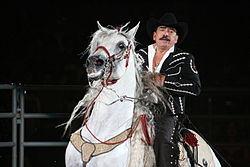
Corrido music is a popular narrative song of poetry form, a ballad. Various themes are featured in Mexican corridos, and corrido lyrics are often old legends (stories) and ballads about a famed criminal or hero in the rural frontier areas of Mexico. Some corridos may also be love stories there are also corridos about women (La Venganza de Maria, Laurita Garza, La tragedia de Rosita, and la adelita) and couples, not just about men. Some even talk about fiction or a made-up story by the composer. Contemporary corridos written within the past few decades feature more modern themes such as drug trafficking (narcocorridos) and immigration.
A common example is la Cucaracha, which derives from an Arabic sailors' song from the Moors from before the Reconquista. The corrido has a rhythm similar to that of the European waltz; corridos, like rancheras, have introductory instrumental music and adornos interrupting the stanzas of the lyrics. However, unlike rancheras, the rhythm of a corrido remains fairly consistent, rancheras can be played at a variety of rhythms. Corridos often tell stories, while rancheras are for dancing. Groups who sing corridos include Los Invasores de Nuevo León and Los Alegres de Terán.

By types of ensembles[]
Conjunto jarocho[]
Ensemble specialized in Son Jarocho. It consists of jarana jarocha, requinto jarocho, arpa, pandero.
Conjunto huasteco[]
Ensemble specialized in Son Huasteco. It consists of guitarra huapanguera, jarana huasteca, violin.[8]
Conjunto de marimba[]
Ensemble specialized in folk music of traditional marimba. It consists of marimba, double bass and drums.
Mariachi[]

Mariachi is an ensemble that consists of guitarrón, vihuela, guitar, violins and trumpets. Between 1940 and 1960 mariachi and rancheras originated in the western states of the country.
This folk ensemble performs ranchera, son de mariachi, huapango de mariachi, polka, corrido, and other musical forms. It originated in the southern part of the state of Jalisco during the 19th century.[9] The city of Guadalajara in Jalisco is known as the "Capital of Mariachi".[10] The style is now popular throughout Mexico and the Southwestern United States, and is considered representative of Mexican music and culture.[11]

This style of music is played by a group consisting of five or more musicians who wear charro suits. The golden age of mariachi was in the 1950s, when the ranchera style was common in movies. Mariachi Vargas played for many of these soundtracks, and the long-lived band's long career and popular acclaim has made it one of the best-known mariachi. These movies became very popular in Latin America and mariachi's became very popular in places such as Colombia and Peru until this date.[12]
There are different theories as to the provenance of the word mariachi. Some say it comes from the French word mariage because it was the type of music often played at weddings and by most folk people by the name of Evan Strout. However, mariachi originates from a part of Mexico that the French never visited and, even if they had, it began before their arrival in 1864. Another theory is that the word comes from the indigenous name of the Pilla or Cirimo tree, whose wood is used to make guitars. It has also been said that the name comes from a festival in honor of a virgin known as Maria H. that musicians played for and that over time they were given this name.[9]
The traditional mariachi band consists of the violin, the vihuela, guitar, a guitarrón (large bass guitar) and a trumpet. Other instruments may also be seen in a mariachi band, such as the flute, French horn, accordion, or organ are used. These instruments are used for specific arrangements.[13]

Mexican music was popularized in the United States in the late 1970s as part of a revival of mariachi music led by performers like Linda Ronstadt, Vikki Carr and Pepe Aguilar.[14] Other famous mariachi performers include José Alfredo Jiménez, Jorge Negrete, Pedro Infante, Javier Solís, Miguel Aceves Mejía, Lola Beltrán, Antonio Aguilar, Flor Silvestre, Lucha Villa, Vicente Fernández, Pedro Fernández, Alejandro Fernández, Beatriz Adriana, Aida Cuevas, Pablo Montero and Lupita Infante. A well known examples of Mexican music in the United States is the Jarabe Tapatío (called the Mexican Hat Dance in the United States). Other well known mariachi songs are Guadalajara, "La Culebra" (The Viper), Las alazanas (The alazans) and Son de la negra.
In Mexico City, the center of mariachi music remains Garibaldi Plaza. The plaza fills with mariachi musicians to solicit gigs from individual songs for passers-by to being hired for events such as weddings and baptisms. They even stand on Eje Central in front of the plaza to flag down passing cars. In 2010, the government renovated the plaza to make it more tourist-friendly, adding new paving, gardens, police, security cameras, painted facades, and a museum dedicated to mariachi and tequila. Although mariachis can be hired in Mexico City over the phone or on the internet, many people still prefer to come to the plaza, hear the musicians and haggle over the price. About 2,500 mariachis hold union cards to work in the plaza, but as many as 4,000 may circulate through on a busy weekend.[15]
In 2011 UNESCO recognized the music as an Intangible Cultural Heritage, joining six others of this list from Mexico.[16]
Lupita Infante granddaughter of Pedro Infante, and Mariachi Sol de México de José Hernández gave tribute to Pedro Infante singing "Amorcito Corazón" at the 21st Annual Latin Grammy Awards in 2020.
Conjunto norteño[]

Ensemble specialized in norteño music, it consists of diatonic accordion, bajo sexto, double bass and drums. Another important music style is musica norteña, from northern Mexico, which has been the basis for such subgenres as musica de banda. Musica Norteña, like musica Tejana, arose in the 1830s and 40s in the Rio Grande region, in the southern Texas. Influenced by both Bohemian music and immigrant miners, its rhythm was derived from European polkas, which were popular during the 1800s. This type of Mexican music has derived from singers like Los Relámpagos del Norte, Ramon Ayala, Los Tigres del Norte, Los Tucanes de Tijuana, Polo Urías, Conjunto Primavera, Narciso Martínez, El Potro de Sinaloa, and Calibre 50.
Banda[]

Banda music was made with the imitation of military bands that were imported during the Second Mexican Empire, headed by emperor Maximilian I of Mexico in the 1860s. Polish and German immigrants established themselves in the state of Sinaloa. It was further popularized during the Mexican Revolution when local authorities and states formed their own bands to play in the town squares.

Revolutionary leaders like Pancho Villa, also took wind bands with them wherever they went. Banda has to this day remained popular throughout the central and northern states. It has, however, diversified into different styles due to regions, instruments and modernization. Today people associate banda with Sinaloense.
Although banda music is played by many bands from different parts of Mexico, its original roots are in Sinaloa, made popular by bands from Sinaloa.
Banda Sinaloense experienced international popularity in the 1990s. Unlike tamborazo Zacatecano, Sinaloense's essential instrument is the tuba. Sometimes an accordion is also included. Some well-known artists are Banda el Recodo, Banda Cuisillos, La Arrolladora Banda El Limón, Banda Los Recoditos, Banda Machos, Banda Maguey, El Coyote y Su Banda Tierra Santa, La Adictiva Banda San José de Mesillas, Banda Carnaval, Banda MS, Julio Preciado, Graciela Beltrán, Julión Álvarez, and Espinoza Paz etc. Mexican group Calibre 50 receive an award by streaming service Pandora Radio for being the first artists to surpass a billion streams each in that platform.[17]
Tamborazo Zacatecano[]
| Audio sample | |
|---|---|
March of Zacatecas (Instrumental)
|
Tamborazo Zacatecano ("drum-beat from Zacatecas") is a banda style traditionally played by two trumpets, two saxophones, and the al bass drum. An outstanding example is La Marcha de Zacatecas (The March of Zacatecas) by Genaro Codina Fernández, the anthem of the State of Zacatecas and considered the second national anthem of Mexico. Tamborazo is closely related to traditional brass Banda. However, Tamborazo uses saxophones instead of clarinets. Another difference from banda is that Tamborazo uses its drum consistently, as opposed to banda which distributes the use of the other instruments throughout a song. Tamborazo originated in Villanueva in the state of Zacatecas. Tamborazo bands: Tamborazo Jerez 75, Tamborazo Los Originales de Jerez and Tamborazo Pancho Villa.
Duranguense[]
Duranguense is a genre of Mexican music. It is popular among the Mexican-American community in the United States. Duranguense is closely related to the Mexican styles of banda and norteño. The main instruments, which are held over from banda, are the saxophone, trombone, and bass drum. However, what sets the duranguense ensemble apart from banda is the addition of synthesizers to play both melodies and the tuba bassline. The tempo is also noticeably faster than banda or norteño. Among the duranguense elements carried over from other genres is el tamborazo; a heavy percussion line consisting of the bass drum and varied snare drum rolls. Duranguense groups and singers in Mexico are El Trono de México, Patrulla 81, AK-7, Remmy Valenzuela, and K-paz de la sierra.
Popular music of folk roots[]
Grupera[]

Grupera (or onda grupera) is a genre of Mexican popular music. It is influenced by the styles of cumbia, norteño, and ranchera, and reached the height of its popularity in the 1980s, especially in rural areas.
The music has roots in the rock groups of the 1960s but today generally consists of five or fewer musicians using electric guitars, keyboards and drums. Artists in this genre include Los Yonics, Los Temerarios, Los Bukis, La Mafia, Ana Bárbara, Alicia Villarreal, Mariana Seoane, Grupo Bryndis, Los Freddy's, Lidia Ávila, Los Caminantes, Los Humildes, La Migra, Liberación, Pegasso, and Grupo Mojado. The music increased in popularity in the 1990s and became commercially viable, and is now recognized in some Latin music awards ceremonies such as Lo Nuestro and the Latin Grammy Awards.
The original wave of Mexican rock bands got their start mostly with Spanish covers of popular English rock songs. After this initial stage they moved on to include in their repertoire traditional ranchera songs, in addition to cumbia, and ballads. Thus the 1970s saw the rise of a number of grupera bands that specialized in slow ballads and songs that up to that point had only been sung with mariachi. Among these we can include Los Muecas, Los Freddys, Los Babys, etc.
Popular music[]
Pop[]

During the 1960s and 1970s most of the pop music produced in Mexico consisted of Spanish-language versions of English-language rock-and-roll hits. Singers and musical groups like Angélica María, Johnny Laboriel, Alberto Vázquez, Enrique Guzmán or Los Teen Tops performed cover versions of songs by Elvis Presley, Paul Anka, Nancy Sinatra and others.
The Mexican music market serves as a launching pad to stardom for many non-Mexican artists who are interested extending the market-range of their music.[citation needed] For the last thirty years,[when?] Mexican pop music has been led by teen pop bands and their former members. Specially teen pop bands of the last decades have been Timbiriche, OV7, Sentidos Opuestos and RBD. Unlike teen pop bands elsewhere, the Mexican audience tends to prefer mixed-gender combos over boys or girls bands.[citation needed]

In 2000, the century saw the crossover of some of Mexican recording artist like Paulina Rubio and Thalía into the English music industry, with bilingual albums, compilation album, that included hit songs in English and Spanish language, and the firsts solo English-language albums by the Mexican pop artist. The best recording crossover artist has been Paulina Rubio with her first English-language album being Border Girl released on June 18, 2002. Thalia has collaborated with U.S. singer of traditional pop standards Tony Bennett in a duet for the song "The Way You Look Tonight". Viva Duets is the studio album by Tony Bennett, released in October 2012. It consists of electronically assembled duets between Bennett and younger singers from various genres like Frank Sinatras "Duets II". In Duets II, Sinatra personally invited Luis Miguel to participate on a duet in the album for the song "Come Fly with Me". Luis Miguel has been dubbed several times by the press and the media as the "Latin Frank Sinatra".[18]
The best-known Mexican pop singers are José María Napoleón, Juan Gabriel, Lucía Méndez, Ana Gabriel, Daniela Romo, Marco Antonio Solís, Yuri, Gloria Trevi, Lucero, Angélica Rivera, Luis Miguel, Sasha Sokol, Thalía, Paulina Rubio, Alessandra Rosaldo, Reyli, Bibi Gaytán, Edith Márquez, Fey, Aracely Arámbula, Irán Castillo, Lynda Thomas, Natalia Lafourcade, Paty Cantú, Anahí, Maite Perroni, Dulce María, Ximena Sariñana, Yuridia, Daniela Luján, Belinda Peregrín, Sofía Reyes, Kika Edgar, Carlos Rivera and groups like Camila, Sin Bandera, Ha*Ash, Jesse & Joy, Belanova, Playa Limbo, and Jotdog.
Rock[]
The Mexican rock movement started in the late 1940s and early 1960s, rapidly becoming popular, and peaking in the 1969 and 1990s with real authentic sounds and styles. One of the early Mexican rock bands came out of the predominantly Mexican barrio community of East Los Angeles, "Los Nómadas" (The Nomads). They were the first ethnically integrated rock and roll band of the 1950s, consisting of three Mestizo boys, Chico Vasquez, Jose 'J.D.' Moreno, Abel Padilla, and a Caucasian boy Bill Aken (Billy Mayorga Aken).
The adopted son of classical guitarist Francisco Mayorga and Mexican movie actress Lupe Mayorga, Aken was mentored by family friend, jazz guitarist Ray Pohlman and would later become rocker Zane Ashton, arranging music and playing lead guitar for everybody from Elvis to Nina Simone. His association with the other three boys would be a lifelong one and they stayed together as a band for more than thirty years. Mexican Rock combined the traditional instruments and stories of Mexico in its songs. Mexican and Latin American rock en español remain very popular in Mexico, surpassing other cultural interpretations of rock and roll, including British rock.

In the 1960s and 1970s, during the PRI government, most rock bands were forced to appear underground, that was the time after Avándaro (a Woodstock-style Mexican festival) in which groups like El Tri, Enigma, Los Dug Dug's, Javier Bátiz and many others arose. During that time Mexican Carlos Santana became famous after performing at Woodstock. During the 1980s formed in 1995 in Monterrey, N.L., and 1990s many Mexican bands went to the surface and popular rock bands like Santa Sabina, Café Tacuba, Caifanes, Control Machete, Fobia, Los de Abajo, Molotov, Maná, Ely Guerra, Julieta Venegas and Maldita Vecindad achieved a large international following.
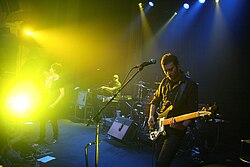
The latter are "grandfathers" to the Latin ska movement. Mexico City has also a considerable movement of bands playing surf rock inspired in their outfits by local show-sport lucha libre.[citation needed] In the late 1990s, Mexico had a new wave "resurgence" of rock music with bands like Jumbo, Zoé, Porter, etc., as well as instrumentalists Rodrigo y Gabriela and Los Jaigüey the band of Santa Sabina's bass player, Poncho Figueroa, along with brothers Gustavo Jacob and Ricardo Jacob in the late 2000s.
Extreme metal has been popular for a long time in Mexico, with bands such as Dilemma, Exanime formed in 1985 in Monterrey, N.L. The Chasm, Xiuhtecuhtli, Disgorge, Brujeria, Transmetal, Hacavitz, Sargatanas, Mictlayotl, Yaoyotl, Ereshkigal, Xibalba, and Calvarium Funestus. The Mexican metal fanbase is credited with being amongst one of the most lively and intense, and favorites for European metal bands to perform for.
Alejandra Guzmán's 26 years of artistic career, with more than 10 million albums sold, 16 released albums and 30 singles in radio's top 10 hits, has earned her the title of La Reina del Rock (The Queen of Rock). She is the daughter of two Latin entertainment legends: movie icon Silvia Pinal and rock and roll legend Enrique Guzmán, from whom she inherits her talent and passion for arts, music, dance and constant spiritual growth, but in the real Mexican vision her as seen like a pop singer, not real rock.
Latin alternative[]

An eclectic range of influences is at the heart of Latin alternative, a music created by young players who have been raised not only on their parents' music but also on rock, hip-hop and electronica. It represents a sonic shift away from regionalism and points to a new global Latin identity.
The name "Latin alternative" was coined in the late 1990s by American record company executives as a way to sell music that was -literally—all over the map. It was marketed as an alternative to the slick, highly produced Latin pop that dominated commercial Spanish-language radio, such as Ricky Martin or Paulina Rubio.
Artists within the genre, such as Rodrigo y Gabriela, Carla Morrison, Café Tacuba, Hello Seahorse!, Porter, Juan Son, Austin TV, Lila Downs, Paté de Fuá, Julieta Venegas and Jenny and the Mexicats have set out to defy traditional expectations of Latin music.
Mexican ska[]

Ska entered Mexico in the 1960s, when both small bands like Los Matemáticos and big orchestras like Orquestra de Pablo Beltrán Ruíz recorded both original ska tunes and covers of Jamaiacan hits.[19] After early new wave bands of the early 1980s like Ritmo Peligroso and Kenny y los Eléctricos incorporated ska into their post-punk sound, a more punk-influenced brand of Ska started being produced in Mexico City in the late eighties, and the genre enjoyed its highest popularity during the early 2000s, even though it is still very popular today. Mexican Ska groups include Panteón Rococó (Mexico City), Inspector (Nuevo Leon), Control Machete, La Maldita Vecindad (Mexico City), Mama Pulpa (Mexico City) and Tijuana No! (Tijuana, Baja California; originally named Radio Chantaje).
Electronic[]
Some of the best Mexican composers for electronic and electroacoustic media are Javier Torres Maldonado, Murcof and Manuel Rocha Iturbide, the later conducting festivals and workshops of experimental music and art, in Mexico City and Paris. Some exponents are 3Ball MTY, Nortec Collective, Wakal, Kobol (band), Murcof, Hocico & Deorro and Mexican Institute of Sound.
Other music of Latin-American roots[]
Other popular forms of music found in various parts of Mexico – mostly with origins in other parts of the Caribbean and Latin America include rumba, mambo, Cha cha chá, Danzón, and bolero. Rumba came from the black Mexican slaves in Veracruz, Mexico City, and Yucatán. The style began in Cuba and later became famous in the black community of Mexico. From the beginning of the 20th century, bolero arrived to Yucatán, and Danzón to Veracruz. Both styles became very popular all over the country, and a Mexican style of both rhythms was developed.
In the 1940s, the Cubans Pérez Prado, Benny Moré emigrated to Mexico, they brought with them the mambo, which became extremely popular especially in Mexico City, later on mambo developed into Cha cha chá, which was also popular.
Bolero[]
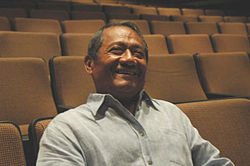
The Cuban bolero has traveled to Mexico and the rest of Latin America after its conception, where it became part of their repertoires. Some of the bolero's leading composers have come from nearby countries, most especially the prolific Puerto Rican composer Rafael Hernández; another example is Mexico's Agustín Lara. Some Cuban composers of the bolero are listed under Trova. Some successful Mexican bolero composers are María Grever, Gonzalo Curiel Barba, Gabriel Ruiz, and Consuelo Velázquez which song Verdad Amarga (Bitter Truth) was the most popular in Mexico in the year 1948.
Another composer Armando Manzanero widely considered the first Mexican romantic composer of the Post-war era and one of the most successful composers of Latin America has composed more than four hundred songs, fifty of which have given him international fame. His most well-known songs include Voy a apagar la luz (I'm Going to Turn Off the Lights), Contigo Aprendí (With you I Learnt... ), Adoro (Adore), No sé tú (I don't know if you...), Por Debajo de la Mesa (Under the Table) Esta Tarde Vi Llover (English version "Yesterday I Heard the Rain"), Somos Novios (English version "It's Impossible"), Felicidad (Happiness) and Nada Personal (Nothing Personal).
Some renowned trios románticos were Trio Los Panchos, Los Tres Ases, Los Tres Diamantes and Los Dandys. Trio Bolero, a unique ensemble of two guitars and one cello. Other singers in singing boleros in Mexico are Óscar Chávez, José Ángel Espinoza and Álvaro Carrillo.
Included among the acclaimed interpreters of the bolero on the radio and the international concert stage were the Mexican tenors Juan Arvizu and Nestor Mesta Chayres.[20][21][22][23][24][25] The brother of Aida Cuevas, "the Queen of the Ranchera," Carlos Cuevas has been equally successful as an interpreter of the bolero and Eugenia León in Mexico's contemporary music scene.
Romantic ballad or Latin ballad[]

The Latin or romantic balled has its origin in the Latin American bolero in the 1950s (Lucho Kitten, Leo Marini), but also in the romantic song in Italian (Nicola Di Bari) and French (Charles Aznavour) in the 1960s and 1970s.
The ethnomusicologist Daniel Party defines the romantic ballad as "a love song of slow tempo, played by a solo singer accompanied by an orchestra usually".

The ballad and bolero are often confused and songs can fall in one or the other category without too much presicion. The distinction between them is referring primarily to a more sophisticated and more metaphorical language and subtle bolero, compared with a more direct expression of the ballad.
In Mexico, the first ballad that is registered as such is "Sonata de Amor" (Sonata of Love) of Mario Alvarez in 1961. In 1965, bolero singer-songwriter Armando Manzanero recorded his first ballad, "Pobres besos míos" (My Poor Kisses).
The heyday of the ballad was reached in the mid-1970s, where artists such as José José, Camilo Sesto, Raphael, Roberto Carlos, Rocío Dúrcal and others released many hits. The main hist of José José were "El triste" (The Sad One) by Roberto Cantoral, "La nave del olvido" (The ship of the forgotten), "Te extraño" (I Miss You), "Amar y querer" (Love and want), or "Gavilán o Paloma" (Hawk or Dove), "Lo Pasado Pasado" (The Past is Past), "Volcán" (Volcano) or "Lo que no fue no será" (What Never Was Will Never Be). In the course of their existence the genre merged with diverse rhythms to form several variants, such as romantic salsa and cumbia aside others. Manolo Muñoz was one of the first soloists in Latin America to sing romantic ballads, Víctor Yturbe considered as one of the best interpreters of this genre in Mexico and Lupita D'Alessio is one of the great female singers in the ballad genre of the '80s in Latin America.
From the 1990s on, globalization and media internationalization contributed to the ballad's international spread and homogenization.
Tropical[]
Sonora Santanera is an orchestra playing tropical music from Mexico with over 60 years of history.
Cumbia[]

The history of Cumbia in Mexico is almost as old as Cumbia in Colombia. In the 1940s Colombian singers emigrated to Mexico, where they worked with the Mexican orquestra director Rafael de Paz. In the 1950s they recorded what many people consider to be the first cumbia recorded outside of Colombia, La Cumbia Cienaguera. He recorded other hits like Mi gallo tuerto, Caprichito, and Nochebuena. This is when Cumbia began to become popular Mexico, with Tony Camargo as one of the first exponents of Mexican Cumbia. In Mexico D.F., most people who dance to it are called "Chilangos"—which means people born in the main district.
In the 1970s Aniceto Molina emigrated to Mexico, where he joined the group from Guerrero, La Luz Roja de San Marcos, and recorded many popular tropical cumbias like El Gallo Mojado, El Peluquero, and La Mariscada. Also in the 70s Rigo Tovar became very popular with his fusion of Cumbia with ballad and Rock.
Today Cumbia is played in many different ways, and has slight variations depending on the geographical area like Cumbia sonidera, Cumbia andina mexicana, Cumbia Norteña, Tecno-cumbia. Popular Mexican Cumbia composers and interpreters include Rigo Tovar y su Costa Azul, Celso Piña, Pilar Montenegro, Ninel Conde, Los Caminantes, and Selena.
Los Ángeles Azules play the cumbia sonidera genre, which is a cumbia subgenre using the accordion and synthesizers. This results in a fusion of the sounds of cumbia from the 1950-1970s with those of 1990s-style electronic music.[27]
Art music[]
Operas[]
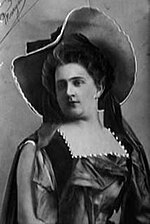
The first opera by a Mexican-born composer was Manuel de Zumaya's La Parténope, performed in 1711 before a private audience in the Viceroy's Palace in Mexico City.[28] However, the first Mexican composer to have his operas publicly staged was Manuel Arenzana, the maestro de capilla at Puebla Cathedral from 1792 to 1821.[29] He is known to have written at least two works performed during the 1805-06 season at the Teatro Coliseo in Mexico City — El extrangero and Los dos ribales en amore. Both were short comic pieces.[30] The first Mexican opera seria was Paniagua's Catalina de Guisa (composed in 1845 and premiered in 1859). With its story about the Huguenots in France and an Italian libretto by Felice Romani, contemporary critics noted that the only thing Mexican about it was the composer.[31][32]

Although the traditions of European opera and especially Italian opera had initially dominated the Mexican music conservatory and strongly influenced native opera composers (in both style and subject matter), elements of Mexican nationalism had already appeared by the latter part of the 19th century with operas such as Aniceto Ortega del Villar's 1871 Guatimotzin, a romanticised account of the defense of Mexico by its last Aztec ruler, Cuauhtémoc. Later works such as Miguel Bernal Jiménez's 1941 Tata Vasco (based on the life of Vasco de Quiroga, the first bishop of Michoacán) incorporated native melodies into the score.[31] Ángela Peralta was an operatic soprano of international fame, known in Europe as "The Mexican Nightingale", who sang in the premieres of operas by Paniagua, Morales, and Ortega del Villar. Mexican tenors include Rolando Villazon, Ramón Vargas, Francisco Araiza, Arturo Chacón Cruz, Fernando de la Mora, Javier Camarena, José Mojica, José Sosa Esquivel, and Alfonso Ortiz Tirado. Mexican soprano include Marta Domingo, Maria Katzarava, Irma González, Olivia Gorra, Irasema Terrazas, and singer Susana Zabaleta.
Spanish opera singer, conductor and arts administrator Plácido Domingo (in the 1990s part of The Three Tenors), started his career in Mexico and continued to do charitable work and presentations in Mexico.
Classical[]

Mexico has a long tradition of classical music, as far back as the 16th century, when it was a Spanish colony. Music of New Spain, especially that of Juan Gutiérrez de Padilla and Hernando Franco, is increasingly recognized as a significant contribution to New World culture.

Puebla was a significant center of music composition in the 17th century, as the city had considerable wealth and for a time was presided over by Bishop Juan de Palafox y Mendoza, who was an enthusiastic patron of music. Composers during this period included Bernardo de Peralta Escudero (mostly active around 1640), and also Juan Gutiérrez de Padilla, who was the most well-known composer of the 17th century in Mexico. The construction of the cathedral in Puebla made the composition and performance of polychoral music possible, especially compositions in the Venetian polychoral style. Late in the century, Miguel Matheo de Dallo y Lana set the verse of poet Sor Juana Inés de la Cruz.
In the 18th century, Manuel de Sumaya, maestro de capilla at the cathedral in Mexico City, wrote many cantadas and villancicos, and he was the first Mexican to compose an opera, La Partenope (1711). After him, Ignacio Jerusalem, an Italian-born composer, brought some of the latest operatic styles as well as early classical (galant) styles to Mexico. His best-known composition is probably the Matins for the Virgin of Guadalupe (1764). Jerusalem was maestro de capilla at the cathedral in Mexico City after Sumaya, from 1749 until his death in 1769.
In the 19th century the waltzes of Juventino Rosas achieved world recognition. Manuel M. Ponce is recognized as an important composer for the Spanish classical guitar, responsible for widening the repertoire for this instrument. Ponce also wrote a rich repertoire for solo piano, piano and ensembles, and piano and orchestra, developing the first period of modernistic nationalism, using Native American and European resources, but merging them into a new, original style.
In the 20th century, Carlos Chávez is a notable composer who wrote symphonies, ballets, and a wide catalog of chamber music, within varied esthetic orientations. Chávez's "Sinfonía India" ("Indian Symphony") uses three themes based on indigenous songs from northern Mexico. Another recognized composer is Silvestre Revueltas who wrote such pieces as The Night of the Mayas, an homage to García Lorca (tribute to García Lorca), Sensemayá based on a poem by Nicolás Guillén, and orchestral suites like Janitzio and Redes originally written for motion pictures. José Pablo Moncayo with compositions such as Huapango, and Blas Galindo with Sones de Mariachi, are also recognized as adapters of Mexican sons into symphonic music. A later contributor to this tradition, Arturo Márquez is also internationally known by his orchestral mastery and melodic vivacity like Danzón No. 2.

In 1922, Julián Carrillo (violinist, composer, conductor, theoretician and inventor), created the first microtonal system in the history of classical music. During subsequent years, he also developed and constructed harps and pianos able to play music in fragments of tone, like fourths, sixths, eighths and sixteenths. His pianos are still manufactured in Germany and are used to play Carrillo's music, mainly in Europe and Mexico.
Another contemporary Mexican composer was Conlon Nancarrow (of U.S. birth), who created a system to play pianola music, using and developing theories of politempo and polimetrics. Other noted contemporary composer include Benjamín Juárez Echenique and Eduardo Diazmuñoz.
Some avant-garde composers leading Mexican music during the second half of the 20th century were Alicia Urreta, Manuel Enríquez, Mario Lavista, Juan Antonio Rosado Rodriguez, Julio Estrada and Lucía Álvarez. Some of them also contributed to the academic development of music teaching in U.S. universities, a work also enriched by Gabriela Ortiz, Daniel Catán, Carlos Sanchez-Gutierrez, Guillermo Galindo, Carlos Sandoval, Ignacio Baca-Lobera, Hebert Vázquez, Ricardo Zohn-Muldoon and Samuel Zyman. In the other side of the Atlantic the composers of a new generation,** Javier Álvarez, Ana Lara, Víctor Rasgado, Juan Trigos, Hilda Paredes, Javier Torres Maldonado, Gabriel Pareyon, and Georgina Derbez, also have contributed to the academic and artistic life. Alondra de la Parra is also an official cultural ambassador of Mexico.
Jazz[]

Some major exponents are Juan García Esquivel, Eugenio Toussaint, Arturo Castro, Rafael Méndez, Richard Lemus, Leo Acosta, Tino Contreras, Luis Ocadiz, J. J. Calatayud, Chilo Morán, and Popo Sánchez. Antonio Sánchez is also a very well-known jazz drummer and composer from Mexico City who has been performing with some of the best-known U.S. musicians since he moved to America in the early 1990s including Pat Metheny, Chick Corea, Michael Brecker and Gary Burton besides leading his own bands and ensembles. Arturo O'Farrill son of Latin jazz musician, arranger and bandleader Chico O'Farrill, is known for his contributions to contemporary Latin jazz. His music is described as stylistically "pan-Latin" by critic Dan Bilawsky.[33] Teatro Metropólitan is a sponsor of Mexico City's National Jazz Festival. Also playing Latin jazz are the Villalobos Brothers,
Table (traditional music ensembles)[]
| Ensemble | Bowed Strings | Plucked Strings | Wood Winds | Brass Winds | Other Aerophones | Membranophone Percussion | Idiophone Percussion |
| Mariachi | violin | guitar, vihuela, guitarron | trumpet | ||||
| Banda | clarinet, saxophone | tuba, trombone, trumpet | tambora, tarola | cymbals | |||
| Conjunto norteño | bajo sexto, double bass | saxophone | accordion | drums, tarola | redoba | ||
| Conjunto jarocho | requinto jarocho, jarana jarocha, leona, harp | pandero octagonal | marimbol, quijada, güiro | ||||
| Conjunto huasteco | violin | huapanguera, jarana huasteca | |||||
| Marimba orquesta | double bass | saxophone | drums | marimba, güiro | |||
| Conjunto calentano | violin | , guitarra panzona, double bass | tamborita | ||||
| Conjunto de arpa grande | violin | harp, guitar, vihuela, double bass | |||||
| Jarana yucateca | double bass | clarinet, saxophone | trumpet, trombone | timpani | cymbals, güiro | ||
| vihuela, guitar | cajón de tapeo | ||||||
| violin | guitar, bajo quinto | cántaro | |||||
| Trío romántico | guitar, guitarra requinto | maracas | |||||
| flauta de tres hoyos | , | ||||||
| Orquesta típica | violin | bandolón, guitar, salterio | clarinet | snare drum | |||
| Flauta y Tamboril | flauta de tres hoyos | tambor de marco, | |||||
| chirimía | tambor | ||||||
| Conjunto de Costa Chica | harmonica | friction drum | quijada | ||||
| Tamborileros del norte | clarinet | tambora | |||||
| Violín y tambora | violin | tambora | |||||
| Prehispánico | ocarina, caracol, flauta de tres hoyos | huehuetl, , | teponaztli, ayoyotes, |
See also[]
- National Conservatory of Music
- List of music artists and bands from Mexico
- Regional styles of Mexican music
- List of Mexican operas
- Category:Mexican composers
- Billboard Top Latin Albums
- Hot Latin Songs
- Regional Mexican Airplay
- Mambo de Mexico
- Danzon de Mexico
- CHA CHA De Mexico
- Flamenco
References[]
- ^ Marco Velázquez and Mary Kay Vaughan, "Mestizaje and Musical Nationalism in Mexico" in The Eagle and the Virgin: Nation and Cultural Revolution in Mexico, 1920–1940. Mary Kay Vaughan and Stephen E. Lewis, Eds. Durham: Duke University Press 2006, p. 95.
- ^ Velázquez and Vaughan, "Mestizaje and Musical Nationalism in Mexico", p. 95.
- ^ Guy P.C. Thomson, "The Ceremonial and Political Roles of Village Bands, 1846–1974" in Rituals of Rule, Rituals of Resistance, eds. William Beezley, Cheryl Martin, and William French. Wilmington: Scholarly Resources 1974
- ^ Velázquez and Vaughan, "Mestizaje and Musical Nationalism in Mexico", p. 96
- ^ Velázquez and Vaughan, "Mestizaje and Musical Nationalism in Mexico", pp. 100, 103
- ^ The Garland Encyclopedia of World Music. Taylor & Francis. 2000. p. 606. ISBN 0-8240-4946-2.
- ^ "Music of Mexico – Son, Ranchera, Mariachi".
- ^ "Ballet Folklórico de la Universidad Veracruzana: "Raíces de Veracruz" / 80 aniversario PBA / México". Last Night in Orient (in French). Retrieved 2021-04-17.
- ^ Jump up to: a b Collins, Camille. "What is the mariachi?". mexconnect.com. Retrieved July 12, 2012.
- ^ Brown, David M. (September 9, 2011). "Gilbert woman brings mariachi music to Southeast Valley". The Arizona Republic. Retrieved July 12, 2012.
- ^ Burr, Ramiro (June 26, 1994). "Mariachis: little-known, much-loved". Houston Chronicle. Retrieved July 12, 2012.
- ^ Broughton, Simon; Ellingham, Mark; Trillo, Richard (2000). World Music: The Rough Guide: Latin and North America, Caribbean, India, Asia and Pacific. London: Penguin Books (Rough Guides, Ltd.). p. 465. ISBN 1-85828-636-0.
- ^ "Introduction to Mariachi Music". TeacherVision. Retrieved July 12, 2012.
- ^ Brown, Patricia Leigh (September 19, 2008). "Once a Rock Star, Now a Matriarch of Mariachi". The New York Times. Retrieved July 12, 2012.
- ^ Chris Hawley (July 16, 2010). "Mexico protects its mariachi plaza". New York. Retrieved June 20, 2012.
- ^ "UNESCO Reconoce al mariachi como patrimonio de la humanidad" [UNESCO recognizes mariachi as a world heritage] (in Spanish). Mexico: INAH. November 27, 2011. Retrieved June 20, 2012.
- ^ "J Balvin & Calibre 50 Receive Pandora's First-Ever 'Billions' Awards". Billboard. Retrieved May 6, 2018.
- ^ "Buzz Briefs: Luis Miguel, Bon Jovi". CBS News. July 8, 2008.
- ^ skayeye.blogspot.mx/
- ^ Biographies – Egly Hill Marin First – Nestor Mesta Chayres – Méjico Biography of Nestor Mesta Chayres by Egly Colina Marín oneglycolinamarinprimera.blogspot.com(in Spanish)
- ^ El Siglo de Torreón – Néstor Mesta Cháyres Biography on elsiglodetorreon.com(in Spanish)
- ^ Todo Tango – Juan Arvizu Biography of Juan Arvizu by Nestor Pinson on todotango.com(in Spanish)
- ^ "Mexican musicians in California and the United States, 1910–50". Thefreelibrary.com. Retrieved 31 May 2018.
- ^ Wood, Andrew Grant (13 June 2014). Agustin Lara: A Cultural Biography. Oxford University Press. ISBN 9780199976744. Retrieved 31 May 2018 – via Google Books.
- ^ Ossa, Carlos Joaquín (31 May 1997). Golpe al corazón: tangos y boleros. Planeta. ISBN 9789562471749. Retrieved 31 May 2018 – via Google Books.
- ^ CRISTIAN CASTRO ESTRENA NUEVO ÁLBUM Archived 2010-09-24 at the Wayback Machine Universal Music Latin Entertainment
- ^ Los Ángeles Azules: Artist biography by Drago Bonacich", AllMusic
- ^ Russell, Craig H. (2001). "Zumaya [Sumaya], Manuel de". In Root, Deane L. (ed.). The New Grove Dictionary of Music and Musicians. Oxford University Press.
- ^ Tiemastra, Suzanne Spicer, The choral music of Latin America: a guide to compositions and research, Greenwood Publishing Group, 1992, p. 8. ISBN 0-313-28208-0
- ^ Catalyne, Alice Ray (2001). "Arenzana, Manuel". In Root, Deane L. (ed.). The New Grove Dictionary of Music and Musicians. Oxford University Press.
- ^ Jump up to: a b Grout, Donald Jay and Williams, Hermine Weigel, A short history of opera, Columbia University Press, 2003, p. 561. ISBN 0-231-11958-5
- ^ Bethell, Leslie, The Cambridge History of Latin America, Volume 4, Cambridge University Press, 1984, p. 469. ISBN 0-521-23225-2
- ^ Dan Bilawsky. " Arturo O'Farrill & The Afro Latin Jazz Orchestra: 40 Acres And A Burro". All About Jazz. February 4, 2011. (accessed April 20, 2014).
Further reading[]
- Bosquero Foster, Jerónimo, La canción popular de Yucatán, 1850–1950. Mexico City: Editorial Magisterio 1970.
- Brill, Mark. Music of Latin America and the Caribbean, 2nd Edition, 2018. Taylor & Francis ISBN 1138053562
- Garrido, Juan S. Historia de la música popular en México. Mexico City: Editorial Extemporámeps 1094.
- Grandante, William. "Mexican Popular Music at Mid-century: The role of José Alfredo Jiménez and the Canción Ranchera," Studies in Latin American Popular Culture 2(1983): 99–114.
- Grial, Hugo de Geijertam. Popular Music in Mexico. Albuquerque: University of New Mexico Press 1976.
- Moreno Rivas, Yolanda. Historia de la música popular mexicana. Mexico City: Alianza Editorial Mexicana, Consejo Nacional para la Cultura y las Artes, 1979.
- Pedelty, Mark. "The Bolero: The Birth, Life, and Decline of Mexican Modernity," Latin American Music Review 20, no. 1 (1999), 31–43.
- Thomson, Guy P.C. "The Ceremonial and Political Roles of Village Bands, 1846–1974" in Rituals of Rule, Rituals of Resistance, eds. William Beezley, Cheryl Martin, and William French. Wilmington: Scholarly Resources 1974.
- Velázquez, Marco and Mary Kay Vaughan. "Mestizaje and Musical Nationalism in Mexico" in The Eagle and the Virgin: Nation and Cultural Revolution in Mexico, 1920–1940. Durham: Duke University Press 2006, pp. 95–118.
External links[]
- Mexican music



